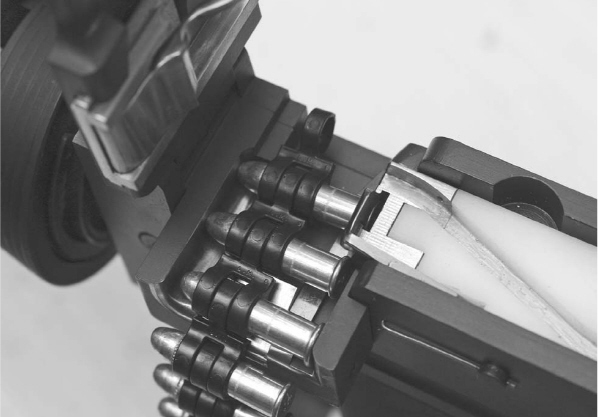
LAKESIDE MACHINE

You must make sure your belt is correctly loaded, or you’ll find the Lakeside not at all happy.
Lakeside does not make firearms. They are a custom machine shop and Class 3 dealer who make one of the choicest accessories for AR owners: a belt-fed .22LR upper. Now, .22LR conversion uppers and internals are nothing new. The fact that the .224” bore diameter of the centerfire and the .221” bore diameter of the rimfire make conversion possible has been known for decades. And the military has been using .22LR conversions in a (wrong-headed) attempt to reduce training costs for decades.
The Lakeside .22LR upper is not intended to be a cheap practice conversion, but a mind-blowing fun gun. Lakeside has been making miniature Browning machineguns (semi-only, due to the grossly punitive Hughes Amendment of the FOPA 1986) for years, and has now applied that knowledge to the LM7, the subject of ours inquiry.
The LM7 upper comes as a steel receiver, .22LR barrel, handguards, new buffer, belt boxes and a mag well conversion adapter to hang the belt boxes. You must supply a lower and sights of some kind for all this to find a new home.
The heart of the lakeside conversion is the receiver. Machined from steel and bolted and welded, it holds the bolt, top cover and feed pawl. To attach a barrel, you simply push the barrel into the front of the receiver with the bright flat to the right. Press the barrel lock button (the silver one on the right side) and the barrel will lock home. The threads on the front of the receiver are there to hold your handguards. You can screw on a delta ring assembly and use standard handguards. Or you can screw on just the barrel nut and install railed handguards. Pretty much anything that goes onto a standard AR will fit on the Lakeside LM7. The front sight block looks like a gasblock. It locks in with set screws. Were I setting up an LM7 I think I’d swap out the lakeside front sight block and install something with a higher CDI factor. As the barrel is a straight .750” diameter, you can fit just about anything that goes on a standard AR to your LM7 barrel. The muzzle threads are standard 1/2-28. The receiver has a picatinny rail machined into it for your BUIS or optics. Just how does a belt-fed .22LR work? Anyone who has looked inside of a Maxim or Browning belt-fed will understand everything that is going on. To have a look, push back the latches on the top cover and swing it up. On the bolt (the white thingie you see in the receiver) there is a dogleg-shaped slot. That slot is the actuator channel for the pawl. The bolt goes back and forth, and the slot forces the pawl arm to cycle in and out. It takes with it the feed tray, which shoves the belt forward a bullet’s width each time the bolt cycles. The bolt has a big extractor-looking arm on it. That is the extractor, cartridge remover and ejector. The feed cycle is like this: each round comes up in the belt-feed until it stops at the end of the feed tray. There, the extractor grabs it and hauls it backwards out of the belt. It has to go backwards, for the rim of the .22LR won’t let it go forward. (The same sort of thing happens in a Maxim or Browning. Not all rifle cartridges are rimmed, but it is easier to haul them all backwards, rimmed or not.) The extractor also shoves the round down the bolt face, to line up with the chamber. When the bolt goes forward, the cartridge is chambered.
After firing, the empty is pulled backwards out of the chamber, and pushed down the bolt face again by the next cartridge. They would fall to the ground if you did not have the belt box adapter installed. The two boxes are your belt feed and your belt recovery boxes. The belts are either cloth, like the WWI-era Maxims, Spandaus, Vickers and the rest, or disintegrating plastic. Now, “disintegrating,” in machinegun parlance, does not mean each link falls apart but that the belt falls apart once the rounds are extracted. Each link falls as a separate piece into the recovery box, or on the ground, it you don’t use the box.
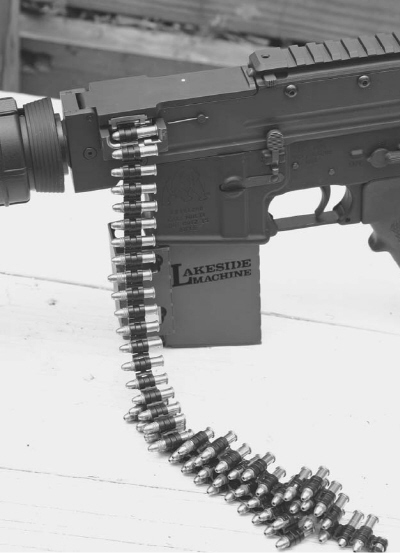
There are .22 conversions, and there are .22conversions. The Lakeside is way beyond fun.
There is one catch to all this: you must use the Lakeside buffer spring assembly to work the action. The .22LR, despite running at much the same pressure as the .38 Special or .45 ACP, generates so little energy that you can’t get the rifle to function with the standard buffer and spring. So the buffer with its built-in spring, and one of the two adapter tubes, must be installed in your lower to use the LM7. For those with a rifle stock, install the longer adapter tube. For telestocks, use the shorter adapter. All that may not be enough. Lakeside includes a replacement hammer spring in case your rifle still has to be “leaned out” more.
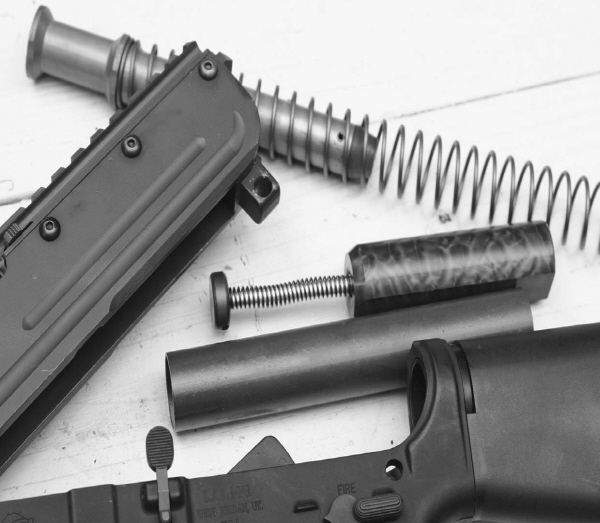
You have to use the Lakeside buffer assembly in your lower. No big deal; it all swaps in or out in a few seconds.
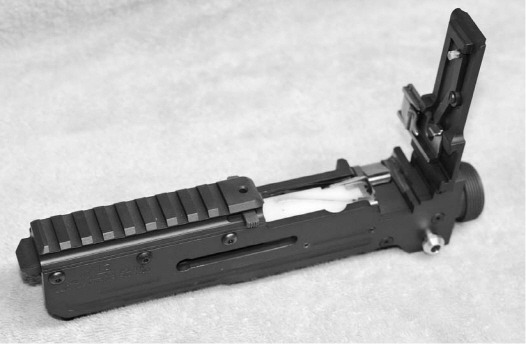
The heart of the Lakeside is a big steel receiver. It weighs a lot.So what? It’s worth the weight when it’s cool!
Now, those of you who have been asking all along, yes, the LM7 works on select-fire rifles. If you’re lucky enough to have, or have access to, an M-16, you can shoot the LM7 full auto. Full, semi, Lakeside can accommodate you. I must, in all fairness, warn you about some drawbacks. The first is that the conversion unit, like all .22LR units adapted to a centerfire design, may take some tweaking and tuning. You may well find 1) that to get yours running 100% you’ll have to have dedicated hammer and hammer and trigger springs; 2) that you can only use particular .22LR ammunition; and 3) that you may have to basically rebuild your rifle each time you want to swap back and forth. If you’re only doing it to a semi-auto AR-15 then don’t beat around the bush: dedicate a lower to it. Build up a rifle for the LM7 only, and tune and tweak until it runs great.

The bolt is recognizable to anyone who has peered into an early-design belt-fed machinegun.
The second drawback is the feeding mechanism. Not that they don’t work. They do. But loading .22LR into anything – belts, magazines, tubes, whatever – always takes longer than shooting said ammo takes. You’ll spend ten or fifteen minutes loading belts and getting the rounds “just right” for your minute or less of shooting. Shooters who lack patience will view that as a drawback. Me, I just view it as the (minor) cost of fun.
Last, the cost of this beautiful machining in steel is weight. The receiver and bolt alone weigh just shy of three pounds. The barrel, basically a sixteen inch tube .750” in diameter, adds over a pound and a half. With the adapter, boxes and a belt of 100 rounds, you have a conversion weight of seven pounds alone. Add in the weight of a lower and you could be the owner of the world’s heaviest rimfire rifle. You are not going to notice the recoil.
For those who are curious, this is just an upper, like any other, as far as the law is concerned. Well, as far as the ATFE is concerned. I can’t imagine something this fun being allowed in places like California, New Jersey or Illinois, so you’d better make a quick check with your state’s regs before you get all fired up to won an LM7. You probably needn’t worry, but you should be sure.
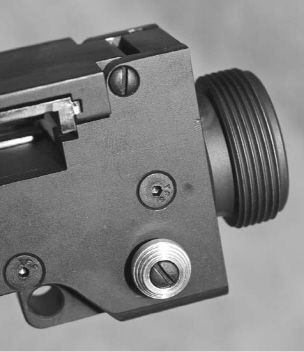
The barrel presses into place and is locked by the silver button. The threads are for your handguards, regular or railed.